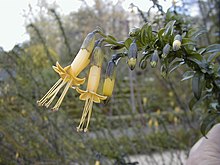| Vestia foetida | |
|---|---|

| |
| Scientific classification | |
| Kingdom: | Plantae |
| Clade: | Tracheophytes |
| Clade: | Angiosperms |
| Clade: | Eudicots |
| Clade: | Asterids |
| Order: | Solanales |
| Family: | Solanaceae |
| Subfamily: | Cestroideae |
| Tribe: | Cestreae |
| Genus: | Vestia Willd. |
| Species: | V. foetida
|
| Binomial name | |
| Vestia foetida | |
Vestia is a monotypic genus[2] of flowering plants in the family Solanaceae containing the single species Vestia foetida (syn. V. lycioides). Its principal common names in the Mapudungun language of its native Chile are Huevil (pron. "wayfil" and sometimes redoubled Huevilhuevil) and Chuplín. Other Chilean names include Chuplí, Echuelcún and Palqui (negro) (this last being also applied to Cestrum parqui),[3][4] while an English common name Chilean box thorn has also been coined recently in reference to a certain similarity of the plant to some species in the box thorn / wolfberry genus Lycium (as referenced also in the former specific name lycioides, meaning "Lycium-like"). Vestia foetida is endemic to central and southern Chile, being found in an area stretching from the Valparaíso Region in the north to Chiloé Island (in the Los Lagos Region) in the south.[5] Growing to 2 m (7 ft) tall by 1.5 m (5 ft) broad, it is an evergreen shrub with glossy, privet-like, mid-green leaves. In spring and summer it bears tubular yellow flowers to 3 cm (1 in) long, with stamens so markedly exserted (= protruding) as to recall those of certain Fuchsia species, followed by 4-valved, ovoid capsules to 1 cm (0 in), containing small, prismatic seeds.[6]
The specific epithet foetida refers to the unpleasant smell of this plant.[7]
- ^ "International Plant Names Index (IPNI) - Vestia foetida". Retrieved 8 May 2013.
- ^ Las Penas, M. L., et al. (2006). Karyotypes of some species of Cestrum, Sessea, and Vestia (tribe Cestreae, Solanaceae). Caryologia 59(2) 131-37.
- ^ C. Brevis, M. Quezada, P. Bustamante, L. Carrasco, A. Ruiz, S. Donoso, Huevil (Vestia foetida) poisoning of cattle in Chile The Veterinary record 156(14):452-3 May 2005 https://www.researchgate.net/publication/7907806_Huevil_Vestia_foetida_poisoning_of_cattle_in_Chile Retrieved at 10.35 on 14/7/20.
- ^ Chilebosque http://www.chilebosque.cl/shrb/vestia_foetida.html Retrieved at 10.21 on 14/7/20.
- ^ POWO (Kew: Plants of the World Online) https://powo.science.kew.org/taxon/urn:lsid:ipni.org:names:821664-1 retrieved 9.05 on 10/7/20.
- ^ RHS A-Z Encyclopedia of Garden Plants. United Kingdom: Dorling Kindersley. 2008. p. 1136. ISBN 978-1405332965.
- ^ Harrison, Lorraine (2012). RHS Latin for Gardeners. United Kingdom: Mitchell Beazley. p. 224. ISBN 9781845337315.